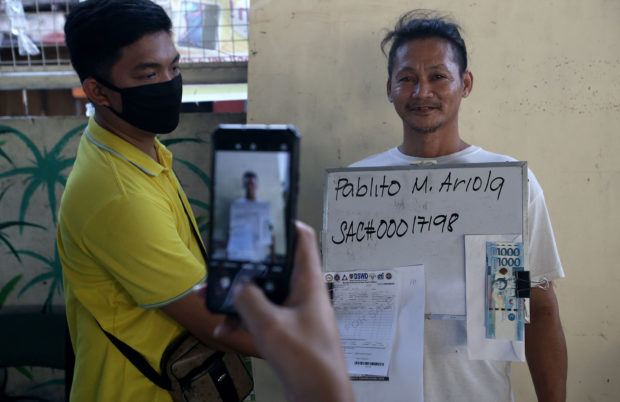
PROOF OF AID A social worker documents the distribution of cash aid to residents of Barangay San Isidro in Parañaque City by having them photographed—together with the wad of P8,000 cash. INQUIRER file photo / RICHARD A. REYES
MANILA, Philippines – A recent survey found out that around 41 percent of Metro Manila residents relied heavily on external monetary assistance while only 33 percent used their own salaries during the COVID-19 lockdown period.
The survey results from the Social Weather Stations (SWS) on Friday — obtained through online interviews from May 4 to 10 — showed that 41 percent of people in Luzon also used the social aid given to them.
This is possibly because enhanced community quarantines and work suspension centered on Luzon and Metro Manila, considered as the epicenter of the local outbreak. A lot of workers who rely on daily earnings and whose jobs cannot adjust to a work-from-home scheme have been left without any income through the lockdown.
“In Metro Manila, 41 percent of families use money amelioration for their daily household expenses, 33 percent use money earned from a job, 26 percent use their personal savings, and seven percent use money-loan,” SWS said.
The number of people who used their salaries to buy goods also varied among Luzon including Metro Manila residents against those from Visayas and Mindanao where lockdowns were enforced locally and separately.
In Visayas and Mindanao, 51 percent and 49 percent respectively used their wages to purchase their family’s needs, compared to the 33 percent of Metro Manila and 43 percent of Luzon. More families in Metro Manila also received relief goods other than any locale, at 12 percent.
Overall, for national averages, 45 percent of Filipinos used the social assistance, 39 relied on their own jobs, 21 percent used money from their own pockets. Another six percent went on to borrow loans.
An average of two percent of families harvested their own crops.
The survey firm however clarified that money amelioration means money given either by the national through the social amelioration program (SAP), through the local government or from relatives.
The SAP is a program of the national government intended to serve 18 million households hard-hit by the quarantine restrictions. As of May 22, the Department of Social Welfare and Development claimed to have distributed P98.4 billion to LGUs for the SAP, while aid has reached 17.4 million families or 97.1 percent of the target number.
According to SWS, they asked 4,010 working Filipinos (15 years and above) the question “Sa kasalukuyan, saan po kumukuha ang inyong pamilya ng pera para sa pang-araw-araw na panggastos sa bahay? (Currently, where does your family get money for daily household expenses?).”
The 4,010 respondents were proportionally distributed in terms of population density, with 294 in Metro Manila, 1,645 in Balance Luzon, 792 from Visayas, and 1,279 from Mindanao. SWS maintains sampling error margins of ±2% for national percentages, ±6% for Metro Manila, ±2 for Balance Luzon, ±3% Visayas, and ±3% in Mindanao.